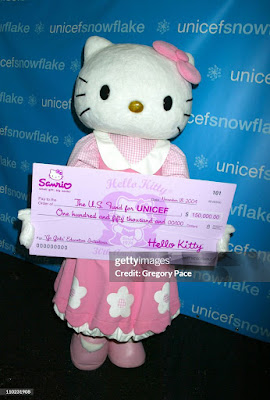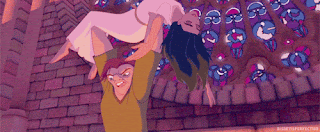In the entertainment business, cartoon characters are treated as real celebrities and public figures with full careers and accolades to match.
Kitty White, commonly known by the moniker "Hello Kitty", is an icon in the daily life of many Asian populations and around the world. As of Feb 7, 2022, Kitty is a billionaire.
According to figures published by Statista, she is the second most valuable media franchise in the world, worth 84.5 billion dollars, just behind Pokémon (105 billion) and far ahead of Mickey Mouse (80.3 billion).
 |
| Mimmy and Kitty |
Sanrio, is the Japanese company that owns her brand and she was brought to prominence by Yuko Shimizu in 1974. Although, Kitty has a twin sister named Mimmy (yellow bow), it is no doubt that Kitty is the undisputed star of the show. Sanrio currently has over 450 characters, from Cinnamoroll to My Melody, Keroppi to Gudetama, alongside their superstar, Hello Kitty.
The anthropomorphic female cat who is of British nationality, lived and grew up in a London suburb with her family, according to her given backstory.
 |
| "Hello Kitty" debuted in 1974 |
However, you can bet with earning power of a billion dollars, she is living far better than your average suburban native in an alternate universe.
Shimizu got the name Kitty from Lewis Carroll's Through the Looking-Glass; during a scene early in the book, Alice plays with a cat she calls Kitty.
UNICEF named Hello Kitty as children's ambassador to the United States in 1983.
 |
| Kitty donates $150,000 dollars to USA's UNICEF |
 |
| Kitty as Special Friend of Children |
By 1987, she got her own television show called, Hello Kitty's Furry Tale Theater. Co-produced by DIC Enterprises and MGM/UA Television Productions, the series involves Hello Kitty and her family and friends re-telling popular fairy tales and stories. The show lasted for one season airing thirteen episode's.
1989 saw the release of the film Hello Kitty: Cinderella released in only in Japan (but was released in English and America later). That same year, she got another shot at series fame with, Hello Kitty and Friends. Her films, Hello Kitty no Oyayubi Hime and Hello Kitty no Mahō no Mori no Ohime-sama followed in 1990 and 1991 respectively.
 |
| Japanese titles of Kitty's films from 1989 to 1991 |
The brands first two video games were released in 1992. In 1994 she was named children's ambassador of UNICEF in Japan. That same year, the Hello Kitty and Friends show came to an end.
Kitty introduced her boyfriend, Daniel Starr often called "Dear Daniel", in 1999. Hello Kitty's Paradise came out in 1999 and was 16 episodes long.
 |
| Kitty as Cinderella in Hello Kitty: Cinderella |
Hello Kitty's popularity in Japan peaked in the late 1990s when she was the country's top-grossing character. The brand went into decline in Japan, but survived due to growth in international markets. In 2002, Hello Kitty lost her place as the top-grossing character in Japan in the Character Databank popularity chart.
 |
| A "Hello Kitty" shop in Madrid |
In terms of profitability, Hello Kitty's brand has flourished due to effective licensing, strategic collaborations, and the ability to expand into various markets worldwide. The brand's presence extends beyond merchandise, including media adaptations such as animated TV shows and films.
She was given the title of UNICEF Special Friend of Children in 2004, a title unique to her.
 |
| "Hello Kitty" jet |
In 2008, Japan named Hello Kitty the ambassador of Japanese tourism in both China and Hong Kong, marking the first time Japan's tourism ministry had appointed a fictional character to the role.
Over the years, Hello Kitty has reached global popularity. Hello Kitty has achieved worldwide recognition and popularity, appealing to people of various ages and cultures. Her unique appearance, has made her instantly recognizable and widely adored by fans across many generations.
 |
| "Hello Kitty" coffee ☕️ |
Regarding competition, Hello Kitty's major rival in the cute character market is generally considered to be Disney's iconic character lineup, including Mickey Mouse, Minnie Mouse, and their associated brands. While both Hello Kitty and Disney characters target similar demographics and employ merchandising strategies, Hello Kitty has managed to carve out her unique space with a distinctive design and cultural impact.
Hello Kitty is also a partner of the United Nations. Kitty and the UN collaborate together with such projects as the #HelloGlobalGoals campaign.
 |
| #HelloGlobalGoals campaign launch |
Yet, no one can compete with Kitty in her own lane. She is a "kawaii" legend.
Hello Kitty embodies the essence of the "kawaii" (cute) culture that has had a significant influence on Japanese popular culture. The character's innocent and lovable nature aligns with the kawaii aesthetic, which has gained global prominence and served as a core element of Hello Kitty's appeal.
In 2024, the Hello Kitty brand will be celebrating it's 50th Anniversary. Kitty White is a solidified and wealthy superstar. 2024 is her year and the world will watch on as she celebrates triumph!
To prove that 2024 is her year indeed, Kitty was made a the grand marshal of the 2024 Northern California Cherry Blossom Festival in San Francisco.
For National Ice Cream Day 🍦🎀 Starting June 21, in collaboration with Van Leeuwen, Hello Kitty created "Yummy Berry White Chocolate Truffle" ice cream flavor made available in scoop shops nationwide. Pints were also made available at most scoop shops. 50% of profits of were vowed to go to kindness.org.
King Charles III of England wished Hello Kitty a happy birthday for her 50th Anniversary during the visit of Emperor Naruhito and Empress Masako of Japan at Buckingham Palace.
Hello Kitty Café Truck making its mobile rounds to fans in various places around the world.
To add, it was announced in October that she would embark on a national tour in Japan to meet and greet fans at various Sanrio shops.
 |
| Hello Kitty Café Truck |
 |
| Hello Kitty 2024 Japan Tour poster |
Check Out The Audio Companion Here: https://youtu.be/zAUVk-LDyoc?si=sBYq4Hev_DciFfDR






.jpg)











.jpeg)


.jpg)



















